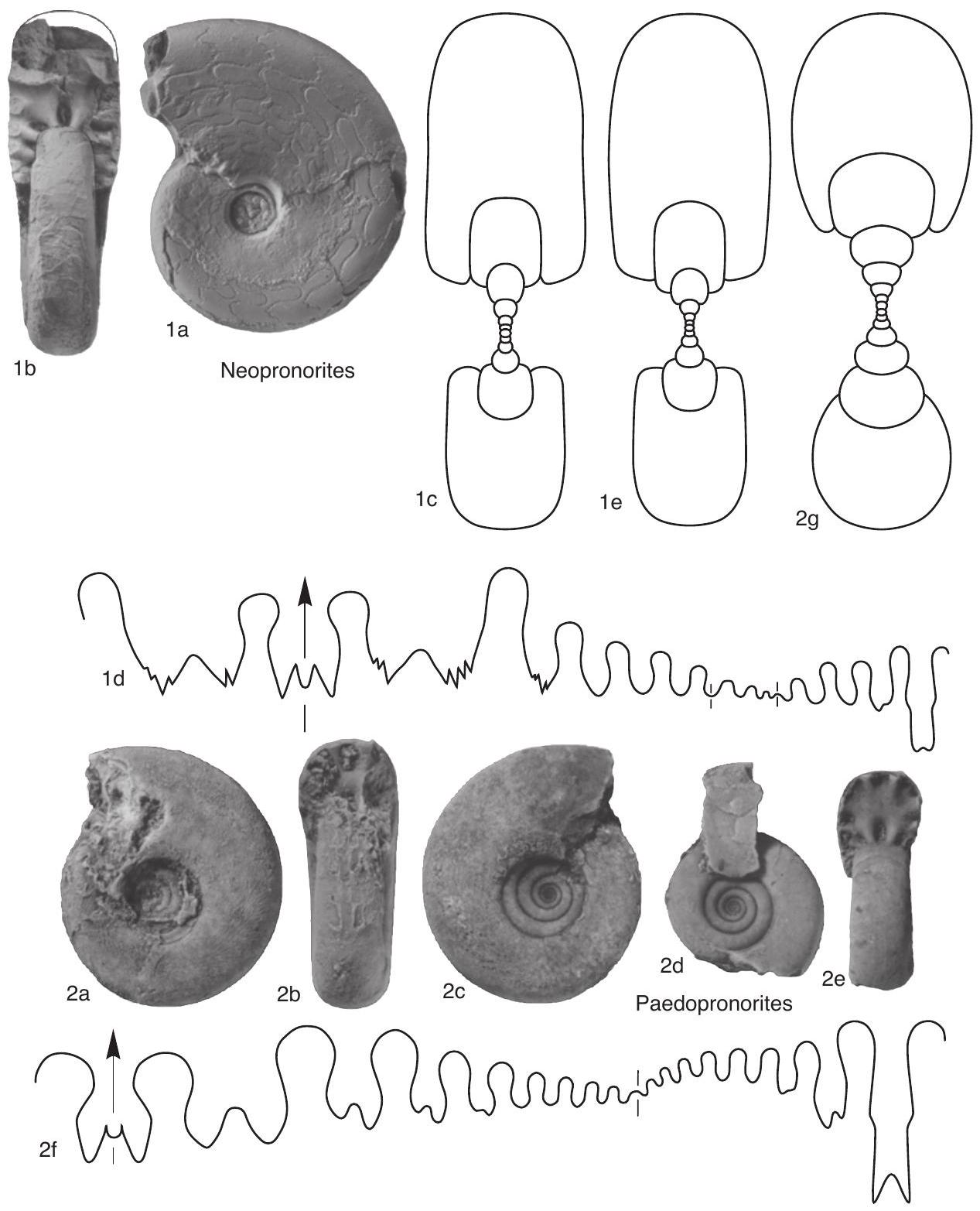Welcome to the Treatise on Invertebrate Paleontology!
Please enter a genera name to retrieve more information.

Neopronorites
Classification
Phylum:
Mollusca
Class:
Cephalopoda
Subclass:
Ammonoidea
Order:
Prolecanitida
Superfamily:
Medlicottioidea
Family:
Pronoritidae
Subfamily:
Neopronoritinae
Formal Genus Name and Reference:
Neopronorites RUZHENTSEV, 1936b, p. 1076
Type Species:
Parapronorites permicus CHERNOV, 1907, p. 344, OD
Images
(Click to enlarge in a new window)
Fig. 124, 1a-d. N. carboniferus Ruzhentsev, Gzhelian, Urals, a-b, × 1, c, hypotype, SUI 62485, northern Kazakhstan, Aidaralash, diameter at 31 mm (new, courtesy of D. M. Work & W. B. Saunders), d, diameter at 42 mm (Ruzhentsev, 1949a).--Fig. 124, 1e. N. tenuis (KarpinskiI), hypotype, SUI 84901, Asselian or Sakmarian, Sholak-Say, Southern Urals, diameter at 34 mm (new, courtesy of D. M. Work & W. B. Saunders).
Synonyms
Epipronorites
Geographic Distribution
Kazakhstan (Southern Urals), Russia (Urals, Verkhoian), Tajikistan (Pamir), China (Guangxi, Guizhou, Xinjiang, Xizang, Gansu), Indonesia (Timor), Thailand (Loei), USA (Texas), Canada (Ellesmere Island)
Age Range
Beginning Stage in Treatise Usage:
Pennsylvanian (Gzhelian)
Beginning International Stage:
Gzhelian
Fraction Up In Beginning Stage:
0
Beginning Date:
303.68
Ending Stage in Treatise Usage:
Cisuralian (Kungurian)
Ending International Stage:
Kungurian
Fraction Up In Ending Stage:
100
Ending Date:
274.37
Description
Neopronoritins characterized by irregular serration in prongs of mature external lateral lobe and one to three adjacent umbilical lobes. Dorsal and adjacent internal lobe bidentate. Seven or eight pairs of umbilically derived lobes in external suture, one-half as many internally. Sutural formula: (V2 V1 V2 )(L1 L1 )UU1 U2 U4 U6 U8 ..... U7 U5 U3 I(D1 D1 ) [Russian]. Fourteen named species. [No suitable illustrations of the type species are available.]
References
Museum or Author Information
Classification
Phylum:
Mollusca
Class:
Cephalopoda
Subclass:
Ammonoidea
Order:
Prolecanitida
Superfamily:
Medlicottioidea
Family:
Pronoritidae
Subfamily:
Neopronoritinae
Formal Genus Name and Reference:
Neopronorites RUZHENTSEV, 1936b, p. 1076
Type Species:
Parapronorites permicus CHERNOV, 1907, p. 344, OD
Images
(Click to enlarge in a new window)
Fig. 124, 1a-d. N. carboniferus Ruzhentsev, Gzhelian, Urals, a-b, × 1, c, hypotype, SUI 62485, northern Kazakhstan, Aidaralash, diameter at 31 mm (new, courtesy of D. M. Work & W. B. Saunders), d, diameter at 42 mm (Ruzhentsev, 1949a).--Fig. 124, 1e. N. tenuis (KarpinskiI), hypotype, SUI 84901, Asselian or Sakmarian, Sholak-Say, Southern Urals, diameter at 34 mm (new, courtesy of D. M. Work & W. B. Saunders).
Synonyms
Epipronorites
Geographic Distribution
Kazakhstan (Southern Urals), Russia (Urals, Verkhoian), Tajikistan (Pamir), China (Guangxi, Guizhou, Xinjiang, Xizang, Gansu), Indonesia (Timor), Thailand (Loei), USA (Texas), Canada (Ellesmere Island)
Age Range
Beginning Stage in Treatise Usage:
Pennsylvanian (Gzhelian)
Beginning International Stage:
Gzhelian
Fraction Up In Beginning Stage:
0
Beginning Date:
303.68
Ending Stage in Treatise Usage:
Cisuralian (Kungurian)
Ending International Stage:
Kungurian
Fraction Up In Ending Stage:
100
Ending Date:
274.37
Description
Neopronoritins characterized by irregular serration in prongs of mature external lateral lobe and one to three adjacent umbilical lobes. Dorsal and adjacent internal lobe bidentate. Seven or eight pairs of umbilically derived lobes in external suture, one-half as many internally. Sutural formula: (V2 V1 V2 )(L1 L1 )UU1 U2 U4 U6 U8 ..... U7 U5 U3 I(D1 D1 ) [Russian]. Fourteen named species. [No suitable illustrations of the type species are available.]
